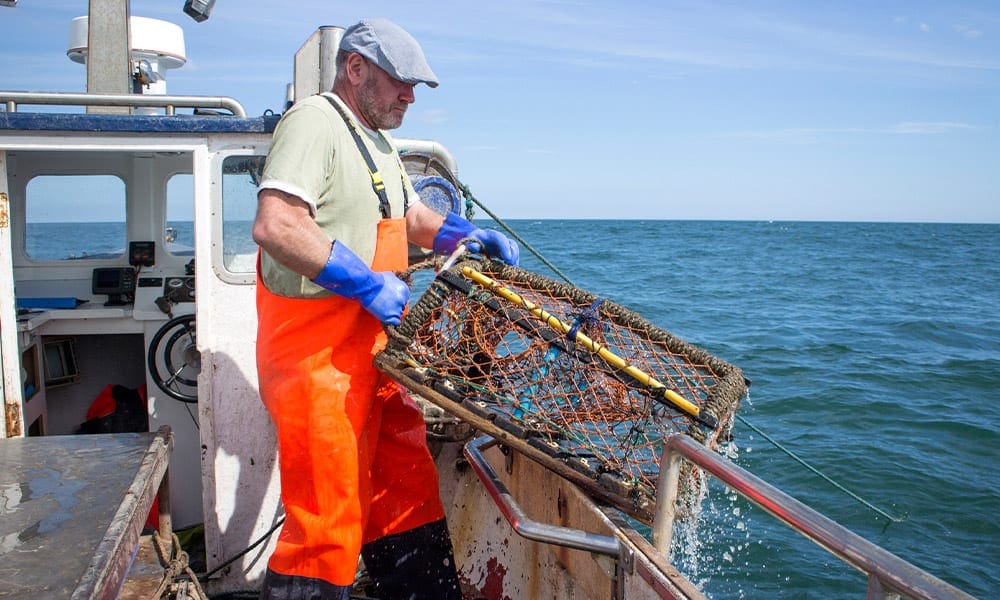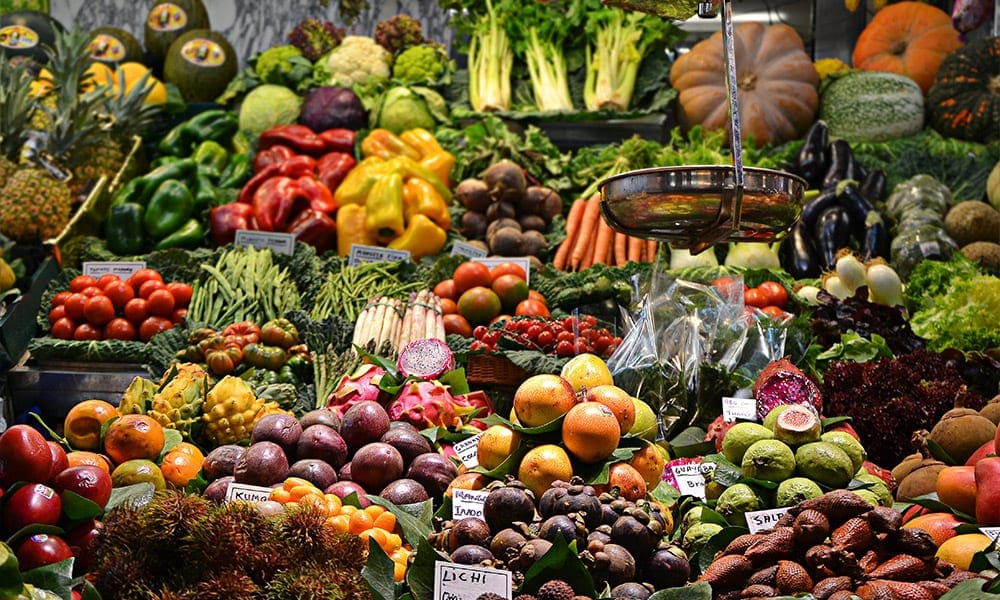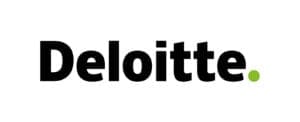Precious cargo: How IoT sensors and AI could help keep perishable goods safe
By Matthew Halliday | March 10, 2021

Nearly 20 percent of all food produced in Canada is lost to avoidable waste along the food supply chain. Tech companies, such as Sedna Technologies and Bluicity, are working to fix that.
Few products are as fickle as a live lobster. From the time they’re hauled from the ocean to the moment they land on someone’s stovetop, they’re susceptible to minute changes in their environment. Stored in water that’s too cold? Dead lobster. Too warm? Dead lobster. Too acidic? Not enough oxygen? Wonky pH? You guessed it.
No one knows that better than Sheamus MacDonald. Growing up in a commercial-fishing family in Cape Breton, Nova Scotia, the 31-year old MacDonald has worked seasonally as a lobster fisher since he was a teenager — enough time to have experienced first-hand the sea change that’s transformed Canada’s lobster supply chains in the past decade.
Not long ago, most lobster caught in Nova Scotia was bound for the United States. But as demand has surged from overseas markets, the industry has been forced to pivot. In 2019, China overtook the U.S. as the biggest destination for Nova Scotia’s lobster industry — and most of that demand was for live animals, rather than processed lobster. “A live product is much more sensitive and vulnerable,” says MacDonald, “and the whole supply chain then becomes much more delicate.”

These challenges, of course, are not exclusive to seafood. According to a recent report by Second Harvest, a Toronto-based “food rescue” charity, nearly 20 percent of all food produced in Canada — worth almost $50 billion annually — is lost to avoidable waste along the food supply chain, from warehousing to distribution to delivery. That’s thanks to everything from bad packaging to lax environmental controls to imprecise demand forecasting. Fortunately, these are also problems that emerging technologies — in particular, predictive analytics, IoT sensors and AI — seem almost tailor-made to address, even if their potential is only just beginning to be tapped.
In 2018, MacDonald founded Sedna Technologies, alongside his former university roommate, Aleksandr Stabenow. Their idea was to apply new tech solutions to address the lobster industry’s age-old problems. The company deploys a mix of IoT sensors and data analytics, up and down the seafood supply chain, monitoring live and farmed products in real time. That allows buyers and harvesters to improve efficiency, move product to market faster and quickly identify problems that cause waste and spoilage.
“Logistics for the food industry is fundamentally not very different than it was 2,000 years ago,” says Bob Burrows, CEO of Bluicity, a Toronto-based supply-chain logistics startup. “It’s all push. You grow everything you can, put it in a truck to go to go downstream and throw out what’s spoiled. That’s why so much of the food grown in the west ends up being thrown away — it’s just the cost of doing business.”
The future of freight
MaRS Supply AI, Canada’s leading virtual event on the supply-chain industry, explores state-of-the-art solutions that are transforming logistics. March 24, 2021.
Register for the event here.
That cost comes due not just in the price of food, but in labour costs and environmental impacts. Burrows founded Bluicity last year, aiming to work with food and pharmaceutical-industry partners to shrink those costs, developing small IOT devices that can accompany food and other sensitive cargos —“anything from a bin of lettuce to 60,000 doses of COVID vaccine,” says Burrows — from one end of the supply chain to the other. “Our perspective is how do we change the way we look at the whole chain of custody,” he says, “from producer to truck to cold room to distribution to retailer.”
Food producers, processors and retailers have used IoT devices for several years now, monitoring everything from temperature to moisture to the respiration rate of produce during transit and storage. In the United States, the Food and Drug Administration’s deputy commissioner, Frank Yiannis, has become an evangelist for the power of emerging technology to usher in a less wasteful and better-traced supply chain. The agency has put together a blueprint for a “new era” of food safety, with tech-enabled traceability at its core.
But the potential is only in its most nascent stages, says Burrows. The big challenge is the paucity of data: “We need massively distributed Internet of Things,” he says.
Today, a distributor may monitor a truck with IoT sensors, and a storage facility may do the same. But coverage isn’t universal throughout the supply chain, sensors aren’t deployed as broadly as they could be, and interoperability between different stakeholders’ data-gathering devices (i.e., farmers, transport operators, storage facilities, retailers, etc.) is fragmented. Burrows instead wants to see IoT that’s universal, comprehensive and live all the time.
With clients that span the entire supply chain, from harvester to purchaser, Sedna’s offers an example as to how this comprehensive approach could work more broadly.
That begins with harvesters. As the market for Nova Scotia lobster has boomed, more harvesters have outfitted themselves with larger boats, going farther out to sea, for days at a time. That means their catch might remain in the boat’s “live well” for longer, which could start lobsters off on the wrong foot before they even get to the dock. For example, if dissolved oxygen levels drop too low, that could affect mortality further down the supply chain.
The same close care needs to hold at each subsequent step, from storage to packaging to shipping. Traditionally, an aquaculture operation might use chemical-test strips to monitor water quality. Sedna’s sensors can monitor them in real-time, pushing notifications to an employees’ phone the moment a problem arises.
That’s a big deal, particularly in the lobster industry, since products now have to make it farther than ever. Whereas most Nova Scotia lobster might once have been shipped to Boston or New York, huge volumes are now being shipped not just overseas, but to ever-more distant markets.
“When we first started in China, they might only get sent to Beijing,” says MacDonald. “But now there are cities 10 more hours away, so now you need to get to Beijing, but then add another leg to the journey, and the product needs to have the stamina to get there.”
Sedna has already expanded beyond Canada, working in the northeastern United States, and has recently opened an office in Norway. The company now plans to take the enormous amount of data it’s generating via sensors and layer in artificial intelligence. That could mean, for example, identifying exactly where mortality strikes along the supply chain, and correlating different factors causing animal stress to identify patterns, and find solutions.
Last December, Sedna became part of Supply Chain AI, a six-month program supported by Canada’s Supply Chains supercluster, Scale AI. The supercluster is focused on AI-based supply-chain optimization, funding and fostering companies that want to introduce AI into their supply chain, and tech companies developing AI solutions.

Julian Billot, Scale AI’s CEO, says that more projects dealing with sensitive and perishable cargo may be right around the corner for the supercluster. Several projects underway already hint at the possibilities to come.
One, at the Port of Montreal, is currently using a machine-learning model to analyze variables including ship arrivals, rail-car deliveries, storage capacity and workforce availability to ensure that critical cargo, including medical supplies and pharmaceuticals used to fight COVID-19, make it out of port as fast as possible.
And a demand-forecasting project with Loblaw is currently analyzing consumer preferences to ensure stores are stocked with alternative products if customers’ preferred choices sell out. A future application could easily work in reverse, says Billot. With more data about purchasing patterns based on geography, seasonality and other factors, a grocery store could forecast demand with more accuracy, reducing over-stock and reducing waste.
But the data has to come first. “We’ve been approached by AI startups on food,” says Bluicity’s Burrows, “but they have no data to work with.”
At the moment, he says, a company like his can prevent waste by pointing at individual problems — identifying a pallet of food sitting in the sun and bringing it inside, for example. Once supply-chain data is rich enough — an abundance of sensors communicating from farm to fork — entire supply chains will be analyzed to identify where loss is most pronounced.
More important still, demand forecasting will be able to precisely predict the tiniest fluctuations in consumer preferences. “That’s where we can really make good on the promise of this technology,” says Burrows, “and see the food world move from push to pull.”
Explore the game-changing solutions that are transforming logistics at MaRS Supply AI event on March 24, 2021. MaRS Supply AI is proudly sponsored by Deloitte. Register here.

 Matthew Halliday
Matthew Halliday